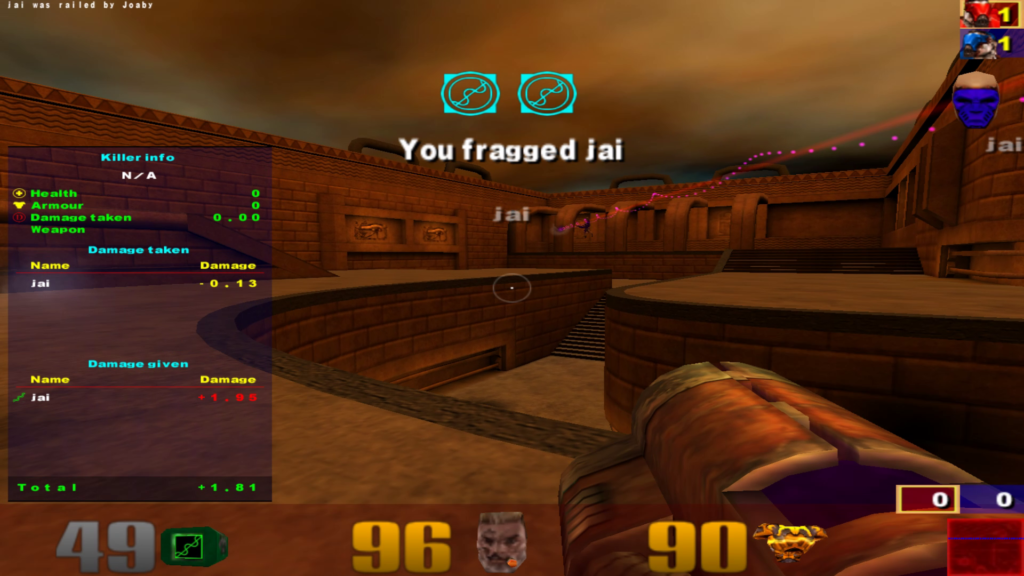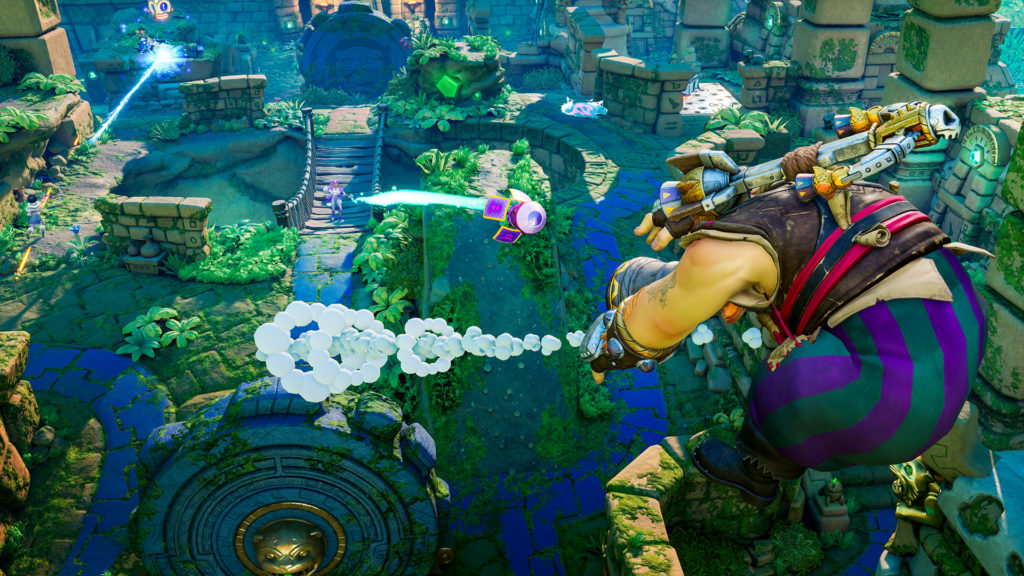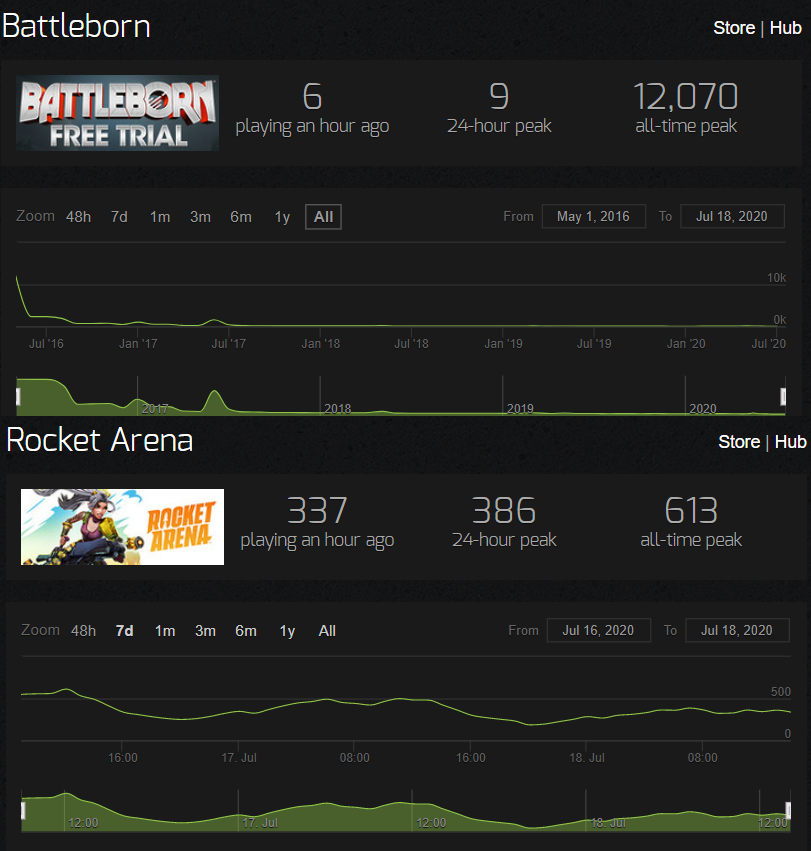Rocket Arena – Review – A Challenger Appears
Back at the turn of the century I played a lot of Quake 3 Arena. Like, a lot of it. And if you played a lot of Quake 3 Arena (back at the turn of the century), you were playing it modded. The serious gamers, the competitive types, they were playing the CPMA or OSP mods. But if you were just there for a goof around you’d be playing the non-stop duel-a-thon that was Rocket Arena 3.
The thing about RA 3 was that it was winner plays on. If you were good enough, you could keep playing for hours at a time. But if you weren’t good, you’d sit out until your turn came up again. And in an eight-player server, that often meant you were waiting a while. Obviously you could spectate and join in on the shit-talking, but if you weren’t winning at Rocket Arena duels, you weren’t playing for very long.

I say this because, as a young gun who spent his fair share of time sitting in the queue waiting for the opportunity to immediately get fragged by Quake players who were better than me, I still think the on-boarding process for Rocket Arena 3 is better than that of 2020’s Rocket Arena from EA and Final Strike Games.
Rocket Arena, out now, is a third-person hero-shooter with Smash Bros. style knockouts instead of frags and, most importantly, rocket jumping.
Think back to the first time you played Smash Bros. Think about how hard that game was. Now make it a third-person shooter. Now add an array of different game modes, all with different rules. Add pick-ups. Add some sort of artifact system that alters how heroes take engagements even further. Add a tutorial that teaches you only the absolute basics.
People are going to need a sherpa just to reach the skill floor with this game.

I think the key sticking point, in my opinion, is the game modes. There are four game modes right from the start, and more are coming. They’re inexplicably not done yet. And it doesn’t make any sense.
First of all, Treasure Hunt is just not a good mode. Half VIP half those blocks from Mario that spit coins everywhere for a limited amount of time, Treasure Hunt feels like a clusterfuck of priorities. Holding the Treasure Chest that spawns in the middle of the map earns your team a heap of coins, and after a set amount of time it despawns. Then the level is littered with coins, and picking them up is a free-for-all.
It’s a mode without a very well-defined goal in terms of moment-to-moment gameplay. When the treasure chest is up, you shoot (or defend) whoever has it, but as soon as the coin phase begins, the fighting stops as everyone scrambles to chart a good path. It is literally detrimental to your team to spend any time fighting during the coin phase, because that’s time not spent… getting coins.
Other games solve this issue by having players bank their coins. Fights can start around the bank as both teams try to turn their vulnerable currency into scored points. Not so here — instead, half of every Treasure Hunt sees players running around after coins and actively avoiding combat.

Mega Rocket seems like it might be the main mode for the game, but that can’t be right. It’s King of the Hill. You capture a zone, that scores a point for your team and the first to score five points wins.
But Rocket Arena is a game based entirely around splash damage weapons. How do you have small zone capture points in a game where almost every single weapon does splash damage? And that doesn’t even account for Hero powers beyond attacks. One hero, Blastbeard, has a single attack that blocks all incoming projectiles and Area of Effect (AOE) damage in a space larger than the entire zone. Others come close. Still others provide essentially no utility in the mode — picking someone like Flux, the newest hero to the game, is a sandbag move because she can’t cap at all while using her invisibility.
Rocketball is probably the best Rocket Arena mode. There’s a ball in the middle, you grab it, you take it to your enemy’s base and you can score it. It’s single flag capture the flag, but you can Kobe the ball from deep — if you’ve got the skills, anyway. It’s a good mode, and it’s well fleshed out. The maps are designed in such a way that each one has its own distinct flavour of Rocketball. Temples of Jaaqua is a small symmetrical map where players can score in mere moments, while The Shimmering Depths takes players on a long journey around its V-shaped layout.
It feels to me like the game would work a little better if the ball moved a touch slower — it can be difficult to position yourself for a Rocket League style “what a save” because the ball is ‘fired’ by the player at a rate that is difficult to intercept unless perfectly positioned. Of course, this could just be a skill ceiling thing — nobody imagined when Rocket League first dropped the sorts of saves (and goals) people would be putting together now.
The final mode, Knockout, is a pretty by-the-numbers mode. It’s team deathmatch, except Final Strike Games placed a lot of emphasis on the fact that nobody dies in Rocket Arena. They’re ‘knocked out’ — bumped from the arena and forced to wait a short period while they return to the fray. Knockout makes a lot of sense — if it was the only mode in the game, I wouldn’t be surprised — because it conveys the Smash Bros. style of gameplay the best.
It’s Rocket Arena at its best, but also its most lopsided. In the other modes, those who can’t get a handle on their hero are still able to help out — they can collect coins, stand in the zone or block a ball. But in Knockout if you can’t contribute to your team it falls on the shoulders of the other two with you.
I can actually see Knockout Rocket Arena being an exciting spectator sport. There’s enough chaos caused by every rocket splash and hero power that at a high enough level, players could put on a real show. It would be a tense spectacle where fantastic shooters play mind games on one another, baiting attacks through feigned mistakes and misplays — it would be like watching top tier Smash Bros. play, but with the added benefit of a 3D space.
But as I said earlier, it’s so damn difficult to learn on the bottom end. Every hero’s primary weapon has a different shooting arc from the last. Some charge to fire, others lob explosives in arcs. Some have to reload every three shots, others can fire for days. And then you have their secondary attacks, and their special abilities.
This sets the skill floor for Rocket Arena desperately high. And worse — it widens the gap on the skill ceiling as well. A new player needs to worry about how their chosen hero fires and what that hero’s abilities are, what the map and mode requires of them, what their teammates are doing and which heroes their enemies are. That’s entry-level for a game with a Ben 10/Kimpossible art style. A game ostensibly aimed at the Saturday morning cartoon crowd.

This doesn’t even take into consideriation team composition. It doesn’t take into account three-stack high skilled players accounting for roles and positioning as they load into a game. Those new players aren’t rocket jumping, or comboing attacks with teammates, or single-target focusing anyone.
Who is this game supposed to be for? Except for a barebones horde mode-lite it is exclusively multiplayer, which screams free-to-play, but it costs $30. It has the aesthetic of a CGI Disney cartoon but you need a helicopter just to reach the base camp for the skill floor. There’s competitive potential here for days, but half the game modes are undercooked.
Multiplayer-only (bot matches don’t count) games live and die on the strength of their community, and the high price of entry immediately puts that in jeopardy. Overwatch was able to get around this thanks to the strength of its community and fanbase, but it’s important to remember that it released alongside — a few weeks after, actually — another hero shooter game that was dead inside of a month.
Battleborn, Gearbox Software’s hero shooter, dropped three weeks before Overwatch, and not even a switch to free-to-play could save it from dying (although Gearbox supported the game for an admirably long time after it had effectively perished). Battleborn launched with 20 times the peak players of Rocket Arena.

If they have enough time, I think Final Strike Games can refine what Rocket Arena is. If they focus on a game with just Rocketball and Knockout, they might even be able to lower the skill floor by improving the tutorialisation. And when — not if, when — Rocket Arena goes free-to-play, I’d recommend giving it a whirl to see whether they were successful at it. As it stands, though, this launch is less a challenger to Overwatch and the hero shooter genre and more a space shuttle disaster.

